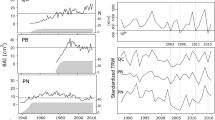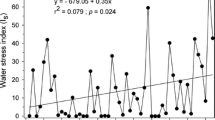Abstract
Tree-ring characteristics in four species were examined to address whether co-occurring mature trees of different successional status respond differently to drought, and whether saplings of these species have a greater response to drought than mature trees. We examined saplings and mature trees of paper birch, yellow birch, red maple and sugar maple, which varied in successional status (shade-tolerance) and co-occurred at Harvard Forest, Petersham, Mass., USA. Three drought events in 1964–1966, 1981 and 1995 were identified using climate data. For mature trees, there was no significant interspecific difference in relative changes in ring-width index (RWI) during the 1964–1966 and 1995 drought events. However, the interspecific difference was significant in the 1981 drought event. Response function analysis for mature trees showed that the radial growth of sugar maple was mainly controlled by spring and summer precipitation, red maple by spring and summer precipitation and temperature, yellow birch by winter and summer precipitation, and spring and summer temperature, and paper birch by spring and summer precipitation and spring temperature. Saplings of sugar maple and yellow birch, but not red maple and paper birch, showed significant positive correlations between RWI and annual total precipitation. In the 1995 drought event, saplings and mature trees of red maple and paper birch differed significantly in drought responses, but this was not true in sugar maple and yellow birch. Our results do not support a generally greater response in saplings than in mature trees, nor an early- versus late successional difference in drought responses.






Similar content being viewed by others
References
Abrams MD (1998) The red maple paradox. BioScience 48:355–364
Abrams MD, Mostoller SA (1995) Gas exchange, leaf structure and nitrogen in contrasting successional tree species growing in open and understory sites during a drought. Tree Physiol 15:361–370
Abrams MD, Ruffner CM, Morgan TA (1998) Tree-ring responses to drought across species and contrasting sites in the Ridge and Valley of central Pennsylvania. For Sci 44:550–558
Bazzaz FA (1979) The physiological ecology of plant succession. Annu Rev Ecol Syst 10:351–371
Bazzaz FA (1987) Experimental studies on the evolution of niche in successional plant populations. In: Gray AJ, Crawley MJ, Edwards PJ (eds) Colonization, succession and stability. Blackwell Scientific, Oxford, pp 245–271
Bazzaz FA (1996) Plant in changing environments: linking physiological, population, and community ecology. Cambridge University Press, Cambridge, UK
Bazzaz FA, Bassow SL, Berntson GM, Thomas SC (1996) Elevated CO2 and terrestrial vegetation: implications for and beyond the global carbon budget. In: Walker B, Steffen W (eds) Global change and terrestrial ecosystems. Cambridge University Press, Cambridge, UK, pp 43–76
Berntson GM (1994) Modeling root architecture: are there tradeoffs between efficiency and potential of resource capture? New Phytol 127:483–493
Bragg WK, Knapp AK, Briggs JM (1993) Comparative water relations of seedling and adult Quercus species during gallery forest expansion in tallgrass prairie. For Ecol Manage 56:29–41
Burns RM, Honkala BH (1990) Silvics of North America. U.S. Department of Agriculture, Forest Service, Washington, D.C.
Carlton GM, Bazzaz FA (1998) Regeneration of three sympatric birch species on experimental hurricane blowdown microsites. Ecol Monogr 68:99–120
Catovsky S, Bazzaz FA (1999) Elevated CO2 influences the responses of two birch species to soil moisture: implications for forest community structure. Global Change Biol 5:507–518
Cavender-Bares J, Bazzaz FA (2000) Changes in drought response strategies with ontogeny in Quercus rubra: implications for scaling from seedlings to mature trees. Oecologia 124:8–18
Clark JR (1983) Age-related changes in trees. J Arboric 9:201–205
Cook ER, Jacoby GC Jr. (1977) Tree ring-drought relationships in Hudson Valley, New York. Science 198:399–401
Donovan LA, Ehleringer JR (1991) Ecophysiological differences among juvenile and reproductive plants of several woody species. Oecologia 86:594–597
Donovan LA, Ehleringer JR (1992) Contrasting water-use patterns among size and life-history classes of a semiarid shrub. Funct Ecol 6:482–488
Donovan LA, Pappert RA (1998) Ecophysiological differences among growth stages of Quercus laevis in a sandhill oak community. J Torrey Bot Soc 125:3–10
Ehleringer JR, Field CB (eds) (1993) Scaling physiological processes: leaf to globe. Academic Press, San Diego, Calif.
Ellsworth DS, Reich PB (1992) Water relations and gas exchange of Acer saccharum seedlings in contrasting natural light and water regimes. Tree Physiol 10:1–20
Foster DR (1992) Land-use history (1730–1990) and vegetation dynamics in central New England, USA. J Ecol 80:753–772
Frazer JM, Davis SD (1988) Differential survival of chaparral seedlings during the first summer drought after wildfire. Oecologia 76:215–221
Fritts HC (1976) Tree rings and climate. Academic, New York
Fritts HC (1996) Quick help for PRECON now called PRECONK Version 5.11. Laboratory of Tree-Ring Research, The University of Arizona, Tucson, Ariz.
Fritts HC, Blasing TJ, Hayden BP, Kutzbach JE (1971) Multivariate techniques for specifying tree-growth and climate relationships and for reconstructing anomalies in paleoclimate. J Appl Meteorol 10:845–864
Grissini-Mayer H, Holmes RL, Fritts HC (1993) International tree-ring data bank program library user’s manual. Laboratory of Tree-Ring Research, University of Arizona
Harper JL (1977) Population biology of plants. Academic Press, New York
Holmes RL (1983) Computer-assisted quality control in tree-ring dating and measurement. Tree-Ring Bull 43:69–75
Jacobi JC, Tainter FH (1998) Dendroclimatic examination of white oak along an environmental gradient in the Piedmont of South Carolina. Castanea 53:252–262
Knapp AK, Fahnestock JT (1990) Influence of plant size on the carbon and water relations of Cucurbita foetididdima HBK. Funct Ecol 4:789–797
Kolb TE, Fredericksen TS, Steiner KC, Skelly JM (1998) Issues in scaling tree size and age responses to ozone: a review. Environ Pollut 98:195–208
Körner C (2000) Biosphere responses to CO2 enrichment. Ecol Appl 10:1590–1619
Kramer PJ (1983) Plant and soil water relationship. Academic, New York
Krebs CJ (2001) Ecology, 5th edn. Benjamin Cummings, San Francisco
Lange OL, Nobel PS, Osmond CB, Ziegler H (eds) (1982) Physiological plant ecology. II: Water relations and carbon assimilation. Springer, Berlin Heidelberg New York
May RM (1974) On the theory of niche overlap. Theor Popul Biol 5:297–332
Norby RJ, Wullschleger SD, Gunderson CA, Johnson DW, Ceulemans R (1999) Tree responses to rising CO2 in field experiments: implications for the future forest. Plant Cell Environ 22:683–714
Ogle K, Whitham TG, Cobb NS (2000) Tree-ring variation in pinyon predicts likelihood of death following severe drought. Ecology 81:3237–3243
Palmer WC (1965) Meteorological drought. Weather Bureau, Res. Pap. No. 45, Washington, D.C., USA
Parrish JAD, Bazzaz FA (1985) Nutrient content of Abutilon theophrasti seeds and the competitive ability of the resulting plants. Oecologia 65:247–251
Sandquist DR, Schuster WSF, Donovan LA, Phillips SL, Ehleringer JR (1993) Differences in carbon isotope discrimination between seedlings and adults of southwestern desert perennial plants. Southwestern Nat 38:212–217
SAS (1999) SAS/STAT User’s guide, Version 8.01 (On-line Docs). SAS Institute, Cary, N.C.
Sipe TW, Bazzaz FA (1994) Gap partitioning among maples (Acer) in central New England: shoot architecture and photosynthesis. Ecology 75:2318–2332
Sipe TW, Bazzaz FA (1995) Gap partitioning among maples (Acer) in central New England: survival and growth. Ecology 76:1587–1602
Spurr SH (1956) Forest associations in the Harvard Forest. Ecol Monogr 26:245–262
Stout BB (1952) Species distribution and soils in the Harvard Forest. Harvard Forest Bulletin No. 24, Harvard Forest, Petersham, Mass., USA
Szeicz JM (1997) Growth trends and climatic sensitivity of trees in the North Patagonian rain forest of Chile. Can J For Res 27:1003–1014
Szeicz JM, MacDonald GM (1995) Dendroclimatic reconstruction of summer temperatures in Northwestern Canada since A.D. 1638 based on age-dependent modeling. Quat Res 44:257–266
Thomas SC, Ickes K (1995) Ontogenetic changes in leaf size in Malaysian rain forest trees. Biotropica 27:427–434
Thomas SC, Winner WE (2002) Photosynthetic differences between saplings and adult trees: an integration of field results by meta-analysis. Tree Physiol 22:117–127
Tschaplinski TJ, Stewart DB, Hanson PJ, Norby RJ (1995) Interactions between drought and elevated CO2 on growth and gas exchange of seedlings of three deciduous tree species. New Phytol 129:63–71
Wayne PM, Bazzaz FA (1993) Birch seedling responses to daily time courses of light in experimental forest gaps and shadehouses. Ecology 74:1500–1515
Wolfe DW, Gifford RM, Hilbert D, Luo Y (1998) Integration of photosynthetic acclimation to CO2 at the whole-plant level. Global Change Biol 4:879–893
Yamaguchi DK (1991) A simple method for cross-dating increment cores from living trees. Can J For Res 21:414–416
Yordanov I, Velikova V, Tsonev T (2000) Plant responses to drought, acclimation, and tress tolerance. Photosynthetica 38:171–186
Acknowledgements
The authors wish to thank D. Orwig, and S. Catovsky for stimulating discussions on the subject and reviewing the research proposal, P. Wayne and T. Sipe for offering ideas that were incorporated into this research, T. Wang for conducting response function analysis, and D. Orwig, J. Cavender-Bares, S. Catovsky, D. Flynn and two anonymous reviewers for comments on the previous version of this manuscript. This research was supported by the China State Key Basic Research and Development Plan (Project 2002CB412502) to J.S.H. and Harvard Forest LTER to F.A.B.
Author information
Authors and Affiliations
Corresponding author
Rights and permissions
About this article
Cite this article
He, JS., Zhang, QB. & Bazzaz, F.A. Differential drought responses between saplings and adult trees in four co-occurring species of New England. Trees 19, 442–450 (2005). https://doi.org/10.1007/s00468-004-0403-2
Received:
Accepted:
Published:
Issue Date:
DOI: https://doi.org/10.1007/s00468-004-0403-2




